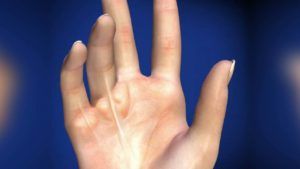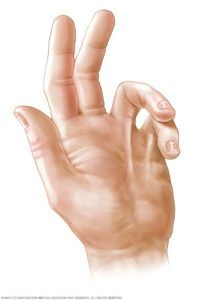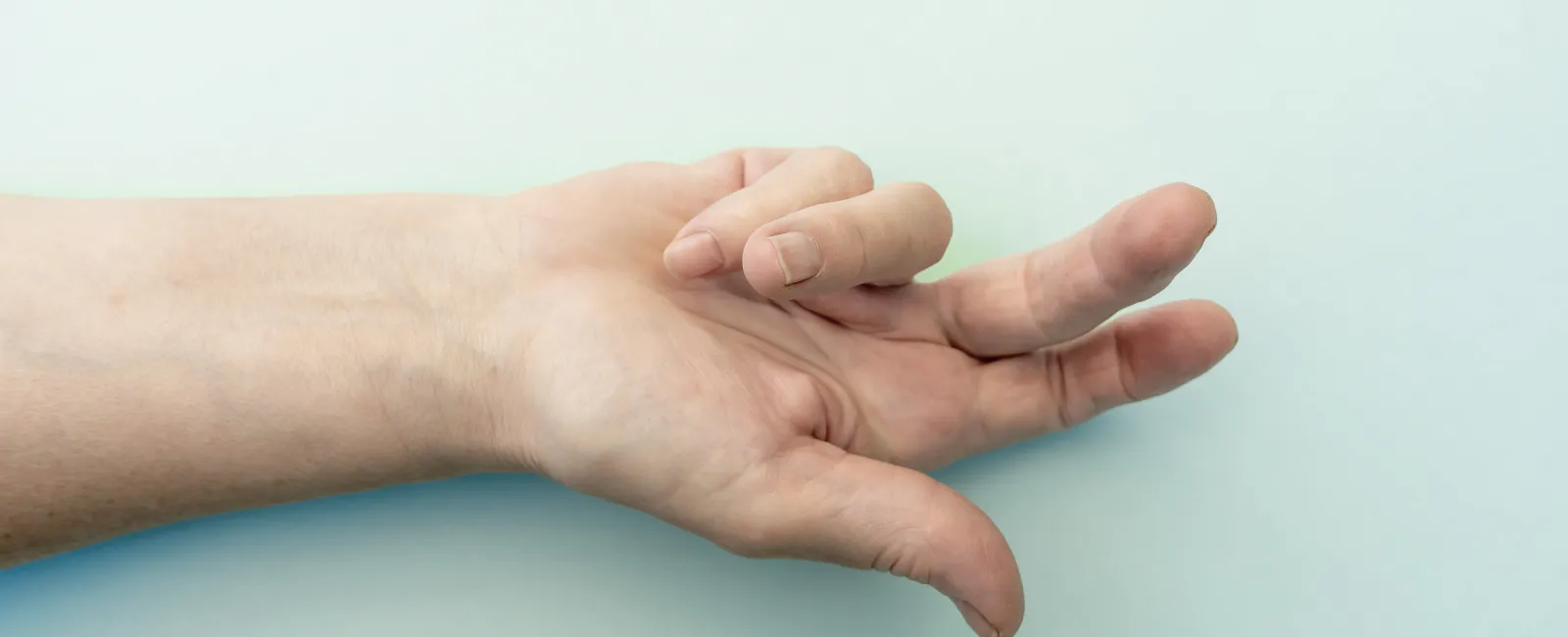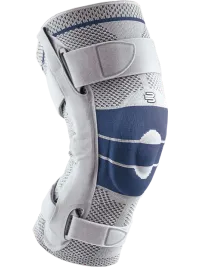A common diagnosis seen by hand surgeons and therapists is Dupuytren's Contracture. Often, patients describe "curled" or "hooked" finger(s) that they cannot straighten. This bent position usually occurs over time and is a nuisance more than anything; however, sometimes, the contracture becomes painful and limiting. [1]

https://www.hopkinsmedicine.org/health/conditions-and-diseases/dupuytrens-contracture
Dupuytren's is a hereditary disease, affecting the tissue in the palm. Generally, it affects men more than women, older adults, and those with Scandinavian descent. The tissue in the palm becomes crossways and hardened, when it should be flexible and in a linear fashion. As this happens, the fingers begin to draw down and remain in a bent position. Patients may begin to notice "rope- like" structures in their palm that can become a nuisance. As the "ropes" become more pronounced, they become limiting and painful. [1][3]

Patients with Dupuytren's contracture begin to notice their finger bending and the inability to straighten. They may notice the finger(s) being "in the way" when they try to put their hands in a pocket or reach down to grab something. The small finger, ring finger, and thumb are the most commonly involved with Dupuytren's contracture. When these fingers are affected, the ability to open jars, hammer things, or use a "power grip" becomes more difficult.
Unfortunately, there is no cure for Duputyren's and it progresses at different rates for different patients. Patients can monitor their symptoms by doing a simple "tabletop test": place your hand palm down on a table top and see if you can flatten your hand; if you cannot and it is painful when you try to, further medical evaluation may be needed by a hand surgeon. [1][2]
Dr. Tyler Cannon, one of OrthoSouth's hand surgeons, says there are various treatments for Dupuytren's but no cure. There are non- invasive options, such as needling or injections but sometimes, he does recommend surgery.
According to Dr. Cannon, there are (typically) three procedures he chooses when treating patients with Dupuytren's:
- Medical or surgical fasciotomy: This involves breaking the cord with either an enzyme injection or by needle/knife in office. The cord is not removed but simply cut in order to gain motion. This procedure may be done in the office setting but does carry with it a higher chance of recurrence.
- Limited fasciectomy: This involves removing abnormal tissues through small incisions; it is a bit more invasive but may allow for a faster recovery. Compared to option #1, there is a smaller risk of recurrence.
- Total fasciectomy: This involves removing the abnormal cord of tissues responsible for the lacking finger range of motion. The incision is typically along the entire cord and removes as much of the cord as possible, to lower the risk of recurrence.
All procedures may be done safely without pain under either local anesthesia or light sedation.
HAND THERAPY
Following surgery, hand therapy can help regain function. Unlike traditional physical therapy, hand therapy is performed by a specialized therapist who focuses on diagnoses of the arm.
Evelyn Daniel OTR/L, CHT is a Certified Hand Therapist who works closely with Dr. Cannon at the OrthoSouth clinic on Primacy Parkway. Evelyn works with patients following surgery for Dupuytren's on a few key points: splinting, range of motion, and strength.
A custom orthosis (splint) that helps keep the patient's fingers/hands straight can be made by Evelyn in the office.
Keeping extension in the fingers and hands is a major goal in the first few visits to hand therapy. Along with a custom orthosis, Evelyn helps her patients work through a range of motion exercises, strengthening exercises, and scar management techniques.
Most surgical patients require less than one month of therapy but hand therapy is a key to success following surgery.
References:
1) Dupuytren's Contracture. (2021, September 29). John's Hopkins Medicine.
2) Mayo Clinic. (2020, October 6). Dupuytren's contracture. Mayo Clinic.
3) Dupuytren's Foundation. (2021, September 29). "What is Dupuytren's Disease?."

